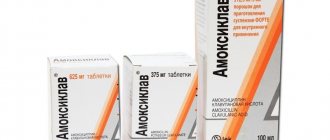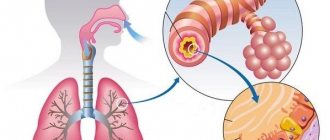With the onset of cold weather, all chronic diseases often worsen, and bronchitis is no exception. Let's consider what it is, what causes it and what complaints bother the patient, how chronic bronchitis is diagnosed and treated.
Bronchitis is an inflammation of the bronchial mucosa. The bronchi are the tubes that carry air to and from the lungs. We have previously described what acute bronchitis is. In this article we will touch on its chronic form.
Both acute and chronic bronchitis are characterized by damage to the tracheobronchial tree.
But if acute bronchitis develops quickly, then chronic bronchitis is a slow disease, but no less unpleasant and even dangerous. This is a more serious disease that develops gradually over time rather than striking suddenly.
By the way, the risk of getting the disease increases with age, and men are 2.5 times more likely to suffer from it than women.
What is chronic bronchitis?
Chronic bronchitis is a long-term, sluggish inflammatory process in the bronchi, which is characterized by progressive damage to the bronchial tree, caused by prolonged irritating effects on the bronchial mucosa of various harmful substances.
It is a common disease, especially among smokers. The diagnosis is made if a cough with or without sputum occurs for at least 3 months a year for 2 years.
Constant inflammation in the bronchial mucosa causes excessive accumulation of mucus in the airways. This limits the amount of air moving in and out of the lungs. Over time, this blockage of airflow increases, leading to difficulty breathing and increased mucus production in the lungs.
Causes of occurrence and exacerbation of chronic disease
This disease is considered one of the most common types of pathologies of the respiratory system. It often develops in workers of “harmful” enterprises and long-term smokers. In children, its development is determined by the structural features of the respiratory system. The occurrence of chronic bronchitis is common in adults. If the symptoms of the disease do not disappear for a long time in a child, then there is a high probability that this is a consequence of constant colds or improper treatment of an acute process.
Exacerbations of chronic bronchitis are repeated several times during the year due to the influence of various stress factors on the bronchial mucosa:
- tobacco smoke;
- dustiness;
- air polluted by smoke or various chemical compounds;
- infection in the lower respiratory tract;
- persistent upper respiratory tract diseases;
- hypothermia;
- heredity.
What are the reasons?
Chronic bronchitis is based on almost the same reasons as its acute form, but in a slightly different sequence.
Read more about acute bronchitis.
If most doctors place the infectious process in the first place as the main cause of acute bronchitis, then for chronic bronchitis the infection is often secondary. The main role here is played by constant exposure of the respiratory tract to irritating substances, namely tobacco smoke, dust, gases and chemicals.
So, here are the main causes of chronic bronchitis:
— tobacco smoke when smoking and its passive inhalation . Constant inhalation of tobacco smoke reduces the natural protective resistance of the bronchial mucosa to damaging environmental factors, leading to a chronic inflammatory process. Almost 90% of all patients are active smokers or have smoked for a long time. Every second smoker over 40 years of age suffers from chronic bronchitis. It is believed that the more cigarettes a person smokes per day, the higher the risk of developing this disease. For example: after stopping smoking, respiratory function indicators improve within 6 weeks.
— inhalation of harmful industrial substances . These include sulfur oxides, products of industrial combustion, coal, oil, and natural gas. Under conditions of constant inhalation of dust, gases and vapors of harmful substances, the self-cleaning mechanism of the bronchi does not have time to remove all accumulated harmful substances, leading to the development of the inflammatory process. As a rule, this is typical for people working in hazardous working conditions, for example, miners, workers in the paint and varnish industry, etc., and is classified as an occupational disease.
- genetic predisposition and congenital characteristics of the bronchial tree . Such people are characterized by increased sensitivity of the bronchi to irritating substances from the outside.
— climatic conditions. Very rarely they are the root cause, but they create a favorable background for the development of the disease. Most often it develops in the so-called off-season: autumn-spring.
- infections. Even now, there is active debate among doctors whether infection plays a primary or secondary role in the development of the disease. But they still tend to believe that the primary role is played by the constant inhalation of irritating substances, and infection is crucial in exacerbating symptoms. Moreover, the trigger for this can be viruses (ARVI, influenza, etc.) and bacteria (mycoplasma, streptococci, Haemophilus influenzae, etc.). It should also be noted that the development or exacerbation of the disease can be caused by infections from the ENT organs: sinusitis, tonsillitis, otitis, etc., when the infection from them spreads to the bronchi. A disrupted process of self-cleaning of the bronchi creates favorable conditions for the proliferation of viruses and bacteria.
- a decrease in the protective function of the immune system creates a favorable background for the exacerbation of the disease and the proliferation of infection.
The main causes of the disease
Respiratory diseases are one of the main factors in the development of bronchitis.
Fertile ground for the formation of the disease is the long-term effect of allergens (irritants) of various nature on the respiratory organs.
For adults, the causes of pathology are working in hazardous industries (mines, quarries, painting works, etc.) and smoking.
Weakened immunity in children leads to frequent colds, viral and allergic diseases and often develops into [chronic bronchitis].
The acute form of the disease in most cases develops into a chronic inflammatory process.
Diseases of the respiratory tract in chronic forms: rhinitis, sinusitis, [tracheitis], [laryngitis] contribute to pathological changes in the bronchi.
Important to know: Treatment of chronic bronchitis of a smoker
An unfavorable factor that influences the development of chronic bronchitis and its frequent relapses is high humidity and cold climate.
How is everything going?
Normally, in a healthy person, every 2 hours the surface layer of the bronchial mucosa is renewed due to the self-cleaning mechanism. The cilia on its surface remove all accumulated particles of dust and harmful substances from the bronchi (small, medium and large) towards the trachea and larynx, thereby preventing the development of inflammation in the bronchi.
In this case, this mechanism is disrupted due to constant inflammation of the mucous membrane and loss of the ability of the cilia on the mucous membrane to remove harmful substances. In addition, their mucus production in the bronchi increases, its composition changes and its viscosity increases.
The disease occurs when the bronchial mucosa repeatedly becomes irritated and inflamed. Constant irritation and swelling can damage the airways and cause sticky mucus to build up, making it difficult for air to move through the lungs. This leads to difficulty breathing, which gradually worsens. Inflammation can also damage the cilia, which are hair-like structures. They help protect the airways from germs and other irritants. When cilia do not work properly, the airways often become a breeding ground for bacterial and viral infections.
After a long period of inflammation and irritation in the bronchi, several characteristic symptoms occur, including a persistent, severe cough that causes mucus to leak from the lungs. The mucus may be yellow, green or white.
Mucus accumulates in the lumen of the bronchi, and in conditions of impaired functioning of the cilia on the bronchial mucosa, it is poorly excreted and stagnates, creating conditions for the proliferation of bacteria and viruses in it. The constant inflammatory process disrupts the normal process of warming, humidifying and purifying the inhaled air, thereby increasing the irritating effect of harmful substances on the bronchi.
Over time, the amount of mucus gradually increases due to increased mucus production in the lungs. Mucus eventually accumulates in the bronchi and restricts airflow, causing difficulty breathing. This shortness of breath may be accompanied by wheezing, which gets worse with any type of physical activity.
In the later stages of the disease, the skin and lips may become bluish due to lack of oxygen in the blood. Decreased oxygen levels in the blood can also lead to peripheral edema, swelling in the legs and ankles.
As the disease progresses, symptoms may also vary in severity and frequency. For example, the cough will go away temporarily, followed by a period of more intense coughing.
One of the adverse consequences is the occurrence of obstruction, i.e. “blocking” the lumen of the bronchi for one reason or another. Namely: thickening of the bronchial mucosa due to inflammation and swelling, proliferation of connective tissue, blockage of the bronchial lumen with mucus, spasm of the bronchi, their collapse on exhalation. Moreover, the process involves both small bronchi and bronchioles, as well as medium and large bronchi. Most of these causes are reversible and may disappear with recovery.
What symptoms might bother you?
The main unfavorable signs are the following:
— cough is the main symptom of chronic bronchitis. It can be dry at the very beginning and bother you mainly in the morning, and as it progresses it becomes moist with the discharge of scanty sputum or in sufficiently large quantities, regardless of the time of day. The cough can be quite strong, annoying and is a reflex act in response to irritation of accumulated sputum with particles of harmful substances.
Moreover, it is important that large and medium-sized bronchi are cleansed first, and the situation with small ones is much more difficult. They lack receptors that respond to accumulated mucus. As a result, they are poorly and practically not cleaned, creating conditions for infection to multiply in them. If the process lasts for a long time, the cough may acquire a barking character, which indicates the addition of obstruction, narrowing of the lumen of the bronchi.
- sputum - at the beginning there may not be any, or the amount is quite small. But as the disease progresses, its production increases, sometimes reaching approximately 100-150g per day. It is mucus at the end of a cough, usually at first light or whitish in color, with a fairly viscous structure. Sometimes the sputum becomes yellow-green, mucopurulent, which indicates the addition of an infection to the disease or the beginning of the development of a purulent process.
- wheezing - if mucus accumulates in the lumen of the bronchi, it disrupts the movement of air. As a result, turbulence occurs, which manifests itself as wheezing, which in a simple case only a doctor can hear. With the development of obstruction, dry rales can be heard at a distance, without special listening.
- shortness of breath - not typical for ordinary bronchitis without signs of obstruction. As the disease progresses and the inflammatory process becomes active, an obstructive component is added. As a rule, patients themselves cannot say exactly when their disease began, since they are accustomed to a constant dry cough for a long time. And they come to the doctor when shortness of breath appears and designate this time as the beginning of the disease. With the obstructive form, shortness of breath appears almost immediately.
- increased sweating , especially at night or with little physical activity.
- hemoptysis is not a typical sign. The appearance of streaks of blood in the sputum indicates a severe course of the disease, when the mucous membrane of the bronchi is torn during a forced cough. If there is sputum with obvious blood or blood is released when coughing, this may indicate a more serious illness, such as cancer or hemorrhagic bronchitis.
- when obstruction occurs and respiratory failure develops, a change in the color of the skin . Blueness appears on the tips of the fingers, nose and lips, ears, or, in severe cases, all skin. This is accompanied by headaches, sleep disturbances, dizziness, and severe weakness. With a long process, the nail plates change like “watch glasses” and the phalanges of the fingers like “drumsticks”.
As we have already said, chronic bronchitis can be non-obstructive and obstructive. They have certain differences:
-non-obstructive bronchitis occurs without complaints of shortness of breath and difficulty breathing, has a seasonality of exacerbation (autumn-spring), clear phases of exacerbation and remission. During the acute phase, it can occur with normal or purulent sputum.
-obstructive bronchitis is characterized by the following three symptoms: cough, sputum, shortness of breath. There is little sputum or it is separated with great difficulty. During an exacerbation, its amount increases, shortness of breath intensifies, and the seasonality of exacerbation and remission is erased. Sputum may be normal or purulent.
Conventionally, the progression of chronic bronchitis is divided into 3 stages:
- stage 1 - simple without obstruction, which is characterized by corresponding symptoms. The bronchi are not yet narrowed and there are no signs of respiratory failure. With proper treatment, further progression of the disease can be avoided at this stage.
-stage 2 - chronic obstructive bronchitis. The bronchi at this stage have already been narrowed for a long time and this stage is characterized by typical signs of respiratory failure.
-stage 3 - bronchitis progresses to pulmonary emphysema with the development of heart failure.
Diagnosis of chronic bronchitis.
As with diagnosing any other disease, determining the diagnosis begins with a thorough interview with the patient. The doctor finds out the main complaints, when the symptoms appeared or the disease worsened, finds out whether the patient smokes, as well as his working conditions, whether he has allergies and other diseases.
Next, proceed to the following diagnostic measures:
— examination of the patient: at the earliest stages of the disease, visible changes, as a rule, are not detected. In the future, with the progression of the disease and the development of cardiac and respiratory failure, changes in the skin in the form of acrocyanosis may be observed: blueness of the tip of the nose, lips, fingers, and ears is noted. When the process is severe, all skin may have a bluish tint. In parallel with this, there is swelling of the legs, feet, swelling of the veins of the neck, changes in the nails and tips of the fingers of the hands and feet like “watch glasses” and “drumsticks”. The changes described above indicate a severe course of bronchitis and the loss of the ability of the bronchi to conduct oxygen to the alveoli and remove carbon dioxide from the lungs, as well as a disturbance in the functioning of the heart due to this.
- Auscultation of the lungs. This is the simplest and most accessible method of listening to the lungs to every doctor. During the normal course of the disease in the remission phase, no changes in breathing in the lungs are observed. In the acute phase, breathing is harsh with dry, scattered wheezing, i.e. wheezing is heard in all parts of the lungs and has a sharp, high-pitched, musical tone.
By the way, by the tone of wheezing you can determine what caliber of bronchi are involved in the process. Low, buzzing wheezes of low timbre, disappearing and reappearing after coughing, indicate involvement of large-caliber bronchi. Wheezing, heard especially on exhalation, is characteristic of damage to small-caliber bronchi.
As mucus accumulates in the bronchi, the wheezing changes from dry to wet, resembling the crunching of large, medium and small blisters. If the process has gone far and pulmonary emphysema has developed (dilation of the smallest bronchi-bronchioles), breathing becomes weakened in all departments.
- percussion of the lungs. It involves tapping the lungs and identifying pathology by the nature of the tapping. With an uncomplicated course of the disease, no changes are observed when tapping. When the patency of small bronchi is impaired and emphysema develops, the sound during percussion has a high tympanic tone: it becomes similar to the sound of hitting a drum.
- general blood test: during the acute phase, general signs of an inflammatory reaction are revealed in the form of an increase in ESR, leukocytes and bacilli, but no specific changes are observed.
- a general urine test and a biochemical blood test do not provide any additional information.
- blood gas composition (BGC): in uncomplicated cases, no changes are observed; with the development of respiratory and heart failure, signs of hypoxemia are observed, indicating a disruption in the delivery of oxygen to organs and tissues - the oxygen tension in the blood decreases and the carbon dioxide tension increases.
- X-ray of the lungs: in most patients, if there are no complications, there are no changes in the images of the lungs. During the exacerbation phase, the pulmonary pattern is usually enhanced, i.e. the vessels of the lungs become more clearly defined, which indicates that they are filled with more blood than usual. In 30% of patients, there are signs of emphysema (the so-called increased airiness), enlargement of the heart as a result of the development of heart failure, as well as other changes, for example, pneumonia, tuberculosis, lung cancer, etc.
—electrocardiogram (ECG)—gives an indication of possible concomitant diseases of the heart or the development of complications in the form of cardiac arrhythmias, myocardial ischemia, etc.
— study of the functional state of the respiratory system spirometry (SP). This method makes it possible to identify the obstructive component, but only at a later stage, since at an early stage no changes are yet determined.
- bronchoscopy. It is used in severe cases of the disease when additional diagnostics are required. A thin tube is inserted into the respiratory tract and the walls of the bronchi are examined, in which inflammatory changes, pieces of the mucous membrane, and sputum are visible. In cases where the bronchi are clogged with sputum or pus, during bronchoscopy, the bronchi are washed, thereby washing away the plugs and restoring bronchial patency, improving the discharge of sputum. If necessary, pieces of the mucous membrane are taken for biopsy.
— CT, MRI are used in severe cases, when it is necessary to conduct a thorough diagnosis of the patient in order to confirm or refute the disease, when there are doubts about the presence of another disease, as well as to assess the extent of the lesion.
Classification of the disease
Chronic bronchitis can develop into respiratory failure. At the initial stages, this manifests itself in the form of mild shortness of breath, gradually turning into serious disturbances in the body’s ventilation processes.
Important to know: Medicine for chronic bronchitis - which one to choose?
Against the background of a relapse of chronic bronchitis in adults, “concomitant” diseases begin to appear in acute forms, such as: coronary heart disease, diabetes mellitus, encephalopathy, etc.
Depending on the form of the disease, the course of treatment and the most suitable medications are determined. Classification of bronchitis in adults is made according to the nature of the inflammatory reaction in the bronchi.
There are several common types: fibrinous, purulent (sputum contains patches of pus), catarrhal (the simplest, changes are minor).
According to the degree of damage to the bronchi, chronic bronchitis is divided into proximal form (covers large bronchi) and distal (changes in small bronchi).
Over the course of a year, chronic bronchitis in adults can worsen up to several times.
The advanced form of the disease leads to serious complications, especially respiratory failure, chronic cor pulmonale, and emphysema.
The fight against these pathologies involves long-term therapeutic treatment of chronic bronchitis.
How to treat chronic bronchitis?
Modern trends in the treatment of chronic bronchitis mean that it should be started as early as possible. This will help to cure it in the early stages and thereby avoid quite serious consequences.
Treatment begins, first of all, not with prescribing medications, but with avoiding inhalation of harmful substances. This is an important condition for successful therapy. And in general, you will need to reconsider your lifestyle in many ways.
If you smoke, you need to stop. Of course, not all smokers succeed in this due to psychological dependence on tobacco smoke. But for those who quit smoking, the symptoms of bronchitis disappear within 4-6 weeks after the last cigarette smoked.
If your work involves inhalation and contact of harmful chemicals or steam, then you need to think about easier work or temporarily avoid contact with these substances.
1. Anti-inflammatory and antipyretic drugs. Used to combat the inflammatory process in the bronchi and reduce body temperature, if it is above 38.3C.
Ibuprofen is used for these purposes: adults and children over 12 years of age are prescribed 200 mg 2-4 times a day (maximum daily dose 1200 mg, no more than 6 tablets in 6 hours). Children under 12 years of age with a body weight above 20 kg - 1 tablet 4 times a day with an interval of every 6 hours.
Paracetamol for adults and adolescents weighing more than 60 kg - 500 mg 3-4 times a day (maximum 4 g per day). Children aged 6-12 years are prescribed 250-500 mg at a time, 1-5 years - 120-250 mg at a time, from 3 months to a year - 60-120 mg per dose, up to 3 months - at the rate of 10 mg / kg .
Acetylsalicylic acid is prescribed to adults at a rate of 0.25-0.5 mg 3-4 times a day. In severe cases, they resort to hormones, but more often in the allergic form of acute bronchitis.
Aspirin (Acetylsalicylic acid) is not recommended for children under 12 years of age due to the possibility of developing Reye's syndrome, a life-threatening condition characterized by cerebral edema and fatty liver degeneration!
2. Antitussive drugs - prescribed by a doctor exclusively in case of a dry, painful cough. And only for a short period of time, because by eliminating the cough, they thereby complicate the discharge of sputum that appears during this period.
Cough preparations include: Sinekod in the form of syrup is prescribed for children 3-6 years old, 5 ml 3 times a day, for children 6-12 years old, 10 ml 3 times a day, for children over 12 years old and adults, 15 ml 3 times a day. Sinekod is also used in the form of drops: children from 2 months to 1 year - 10 drops 4 times a day, from 1 year to 3 years - 15 drops 4 times a day, over 3 years old, adolescents and adults are prescribed 25 drops 4 times a day.
The antitussive drug Stoptussin is prescribed after dissolving in 100 ml of warm water, at the rate of: up to 7 kg-8 drops 3-4 times a day, 7-12 kg-9 drops 3-4 times a day, 12-30 kg-14 drops 3 times per day, 30-40kg-16 drops 3-4 times a day, 40-50kg-25 drops 3-4 times a day, 50-70kg-30 drops 3-4 times a day, above 70kg-40 drops 3- 4 times a day.
Libexin as a cough remedy is prescribed for adults 0.1 g 3-4 times a day, in severe cases 0.2 g 3-4 times a day, for children 0.025-0.05 g 3-4 times a day. Swallow the tablet whole without chewing to avoid anesthesia of the larynx.
3. Mucolytics - used in the presence of thick sputum that is difficult to separate. Their goal is to make phlegm more liquid, thereby facilitating its coughing up.
First of all, acetylcysteine (ACC or Fluimucil) is taken: for adults and adolescents over 14 years old, 200 mg 2-3 times a day (ACC100 or ACC200) or 600 mg 1 time a day (ACC Long). Children 6-14 years old: 1 tablet (ACC100) 3 times a day or 2 tablets (ACC100) or 1 tablet (ACC200) 2 times a day. Children from 2 to 5 years old are prescribed 1 tablet (ACC100) or 1/2 (ACC200) 2-3 times a day.
Ambroxol (or Lazolvan): adults and children over 12 years of age are prescribed 30 mg 3 times a day. in the first 2-3 days, then 30 mg 2 times a day. or 15 mg (half a tablet) 3 times a day. Children 6-12 years old: 15 mg (half a tablet) 2-3 times a day. It is not recommended to use without medical prescription for more than 4-5 days. Among herbal preparations, plantain syrup is effective: for children under 7 years old, 1 teaspoon 3 times a day, 7-14 years old, 1-2 teaspoons 3 times a day, over 14 years old, and adults, 3-5 teaspoons a day.
Today, there are liquid forms of the above drugs that can be used by inhalation through a nebulizer.
4. Drugs that dilate the bronchi. They are prescribed when an obstructive component is attached, when exhalation is difficult, and are aimed at expanding the narrowed bronchi.
There are several different groups of drugs that are prescribed both by inhalation and in the form of tablets and syrups. Here are the most frequently prescribed of them: of the short-acting drugs, Salbutamol is used by inhalation, 2 breaths during an attack, but not more than 6 times a day, it acts almost immediately, but not for long, and is aimed at emergency resolution of breathing difficulties that have arisen.
Atrovent has the same effect - the effect develops 15 minutes after several breaths, and lasts for 4-6 hours.
Of the long-acting drugs, Clenbuterol is the most effective: for children up to 8 months - in the form of syrup 2.5 ml 2 times a day, from 8 months to 2 years - 5 ml 2 times a day, 2-4 years - 7.5 ml 2 times a day day, 4-6-10ml 2 times a day, 6-12 years old - 15ml 2 times a day, over 12 years old - 15ml 2-3 times a day.
A very effective drug is Euphyllin in tablets: 150 mg for adults 1-3 times a day, for children at the rate of 7-10 mg/kg per day in 4 doses. Duration of use - from several days to several months. Intravenously administered very slowly, pre-diluted in 10-20 ml of 0.9% NaCl or dropwise in 100-200 ml of the same solution: adults 2-4 ml, children at the rate of 2-3 mg/kg, but not recommended for use up to 14 years due to possible side effects. Sometimes an ampoule of aminophylline is diluted in a small volume of 0.9% NaCl and inhaled through a nebulizer.
All of the above drugs are prescribed only by a doctor and only with a prescription!
5. Antibiotics for bronchitis are used when treatment is not effective, purulent sputum appears, and the temperature remains above 38.3 C for more than 3 days. In weakened people, as well as in patients over 60 years of age, with severe concomitant pathologies, antibiotics are prescribed even for mild forms of acute bronchitis almost from the first days of the disease. Since their immune system is weakened, a bacterial infection can quickly join acute bronchitis, for example, of viral etiology.
Antibiotics are prescribed taking into account the sensitivity of the flora sown in sputum or bronchial contents. If sensitivity cannot be determined, then treatment begins with the prescription of semisynthetic ampicillins or macrolides: ampicillin 0.5 g 4 times a day, amoxicillin 0.5 g 3 times a day, amoxiclav 0.625 3 times a day or clarithromycin 0.5 g 2 times a day day, azithromycin 0.5 g once a day. The course of treatment is 7-10 days. If bronchitis has become purulent, then preference is given to fluoroquinolones and cephalosporins of 3-4 generations: levofloxacin 0.5 g once a day or moxifloxacin 0.4 g once a day or intravenous/intramuscular cefepime 2 g 2 times a day, cefotaxime 2 g 3 times a day.
6. Compliance with the drinking regime in order to preserve the cilia on the bronchial mucosa and maintain sufficient viscosity of sputum. Since a lot of fluid is lost with high body temperature and intense sweating, it must be adequately replenished - at least 1.5 liters per day for adults. This can be tea with lemon and honey, compote, fruit drink, juices, mineral water.
It is especially necessary to carefully monitor the delivery of fluid to young children, since they, unlike adults, are able to “lose it” especially quickly, which is more dangerous for them.
These measures will help reduce profuse sweating, reduce elevated body temperature and improve overall well-being, as well as maintain moisture in the mucous membranes of the bronchi, preventing them from drying out.
7. Vitamin C and immunocorrectors - strengthen the vascular wall and have an immunostabilizing effect. Vitamin C is used at 0.1-0.5 mg per day. You can also use vitamin A 3 mg per day. Timalin is prescribed 100 mg subcutaneously for 3 days, T-activin can be used.
8. In some cases, therapeutic bronchoscopy may be necessary to improve the outflow of sputum.
9. Physiotherapeutic procedures in the form of inhalations with anti-inflammatory substances, drugs that dilute sputum, magnetic therapy, UHF, inductothermy, etc. All these procedures are prescribed by a physiotherapist depending on the indications and contraindications for them.
10. Change your lifestyle. Using natural remedies can also help relieve the unpleasant symptoms we discussed above. Here are the simplest recommendations:
- Breathing warm, moist air from a humidifier can relieve coughing and loosen mucus in the airways. Be sure to clean your humidifier regularly according to the manufacturer's instructions. Bacteria and fungi can grow in a container of water if it is not properly treated.
- You should quit smoking immediately if you smoke. If you live in an area with high levels of air pollution, try to wear a mask whenever you go outside. You should also wear a mask if you work in a manufacturing environment where you are exposed to paints or household cleaners with strong fumes. Frequent exposure to these irritants will cause your condition to worsen significantly.
- Physical activity helps strengthen the muscles that help you breathe. Ideally, you should exercise at least three times a week for 30 minutes. If you haven't exercised before, start slowly and gradually increase the duration and intensity of your exercise. Ask your doctor to help you create an exercise plan that's right for you.
- Sometimes difficulty breathing can be relieved by pursing your lips. You take a deep breath and then exhale slowly through your mouth. As you exhale, hold your lips as if you are about to kiss someone. This will help you regulate your breathing and feel better when you are short of breath.
Symptoms, diagnosis and treatment of chronic bronchitis
What is chronic bronchitis?
Chronic bronchitis is a diffuse, inflammatory, steadily progressive disease of the bronchial tree, which develops as a result of constant irritation of the bronchial mucosa by harmful factors from the environment, and when infected, it is characterized by an exacerbation of the inflammatory process. An exacerbation of the disease is accompanied by the appearance of a strong dry cough and slight shortness of breath against the background of a deterioration in the health of the whole organism as a whole. During this period of the disease, the patient is contagious to others. The relevance of this disease is extremely high. Chronic bronchitis is widespread and accounts for approximately 25% of all diseases of the bronchopulmonary system. It is more common in men aged 40–55 years. A patient with chronic bronchitis in the acute stage is contagious to others.
The prognosis for this pathology is questionable; chronic bronchitis is constantly progressing, which negatively affects the work activity and well-being of patients. Deaths are rare and occur only from complications of the disease.
One of the early consequences of the deterioration of the condition is prolonged bronchitis, which is characterized by frequent, prolonged exacerbations of the inflammatory process, against the background of a short remission.
Etiology of chronic bronchitis
The causes of chronic bronchitis are infectious agents that affect the bronchi, which means that all pathological microorganisms entering the bronchial tree can cause inflammation. These include:
- bacteria;
- viruses;
- fungal infection;
- simple microorganisms.
Also, the causes of the disease include provoking factors that affect the human body for years and stimulate the transition of the acute phase to the chronic, or contribute to the development of a process such as prolonged bronchitis.
- The main reason today for the development of a disease such as chronic bronchitis is smoking (active or passive).
- Accommodation in industrial, large cities and megalopolises.
- Work in production facilities for processing ore, metals, wood, etc.
- Frequent and prolonged contact with household chemicals/
- Climatic conditions: low temperature, strong winds, high humidity.
Symptoms of chronic bronchitis
Chronic bronchitis occurs with alternating phases of exacerbation and remission. During an exacerbation, a person is contagious and the symptomatic picture of the disease consists of general intoxication of the body, the causes of which are waste products of pathological microorganisms and direct damage to the bronchopulmonary system.
Intoxication syndrome:
- increased body temperature;
- headache;
- dizziness;
- lack of appetite;
- nausea;
- decreased memory, attention;
- decreased ability to work.
Bronchial damage:
- cough;
- sputum;
- dyspnea;
- rarely hemoptysis (blood in the sputum);
- chest pain.
During the period of remission, the patient is not contagious and the symptoms of the disease become sparse:
- slight cough in the morning with a large amount of mucous sputum;
- shortness of breath on exertion.
Examination by a specialist
This may be a general practitioner, family doctor or pulmonologist, who will determine the duration of the disease, the frequency of exacerbation periods and physical data:
- When percussing (tapping) the chest - a boxy sound, the cause of which is increased airiness of the lungs due to emphysematous dilated bronchioles.
- When auscultating (listening) to the chest, there is weakened breathing and dry wheezing, which is caused by the accumulation of sputum in the bronchi.
Laboratory research methods
- A general blood test, which will be characterized by the appearance of an increased ESR (erythrocyte sedimentation rate), leukocytes and a shift in the leukocyte formula to the left. The cause of such changes is the inflammatory process in the body.
- A general urine test, which will be characterized by the appearance of traces of protein, bacteria and an increased number of leukocytes in the field of view, which means that there is an inflammatory process in the body.
- A general sputum analysis will show an increase in the number of leukocytes and lymphocytes, which speaks in favor of chronic bronchitis.
Instrumental examination
Chronic bronchitis can be determined using only a chest X-ray, which shows a uniform increase in the transparency of the lung tissue due to the accumulation of a large amount of air in the bronchi, which means that the use of expensive examination methods (CT - computed tomography or MRI - magnetic resonance imaging ) is not necessary at all.
Drug treatment
- Antibacterial drugs. To exacerbate the disease in the autumn-winter period, it is relevant to prescribe protected Penicillins (Augmentin, Flemoxin-solutab), which have an antibacterial (promote the death of microorganisms) and bacteriostatic (inhibit the growth, development and reproduction of bacterial cells) effect. The drug is prescribed to adults at 1000 mg 2 times a day. During pregnancy, taking the drug is contraindicated, as allergic reactions often occur. Macrolides have an active bactericidal effect and are also effective against intracellular parasites.
- Azithromycin (Sumamed, Azitro Sandoz, Azitrox). This drug is easy to use and is prescribed to adults at a dose of 500 mg once a day. The course of treatment is 3 days. During pregnancy, the drug is contraindicated.
- Rovamycin is the drug of choice during pregnancy in any trimester. Prescribed 50 thousand units 2 times a day.
- Antitussives - inhibit the cough center in the brain. Prescribed only for intense dry cough. Pregnant women are strictly prohibited from taking medications from this group.
Codeine or Codterpine is prescribed to adults, 1 tablet 2 times a day for 3–5 days. The drug is easy to use, just drink it with a small amount of cool boiled water.
- Mucolytic drugs.
- Acetylcysteine (ACC) has an expectorant and pronounced mucolytic effect. Prescribed 200 mg 3-4 times a day or 800 mg 1 time a day. For pregnant women, this drug is prescribed only in the third trimester.
- During pregnancy, approved mucolytic drugs in all trimesters are Alteyka, Bronchipret, which are easy to use and prescribed in syrup, 1 tablespoon 3 times a day.
- Bronchodilators have a bronchodilator effect and reduce the degree of shortness of breath. The drug of choice for a disease such as chronic bronchitis is Salbutamol, which is prescribed on demand, but not more than 6 times a day in the form of an aerosol. One of the side effects of this drug is contraction of the myometrium (the muscular lining of the uterus), which during pregnancy can lead to abortion or premature birth.
Diet that eases the course of the disease
With a disease such as chronic bronchitis, it is necessary to adhere to proper nutrition. Products should contain large amounts of protein, vitamins and minerals.
Excessive consumption of fatty and carbohydrate foods should be avoided. Also, meals should be fractional, i.e. divided into 6–8 small portions per day.
A balanced diet for this disease is the key to a quick recovery.
Foods to be consumed:
- lean meat;
- fish;
- porridge;
- vegetable broth soups;
- boiled or stewed vegetables;
- eggs;
- milk and fermented milk products;
- bread;
- low-fat cookies;
- chocolate;
- tea, weak coffee.
Foods to avoid:
- fatty meat and fish;
- sausages;
- canned food;
- smoked meats;
- borscht;
- fried, salted, spicy foods;
- alcohol;
- carbonated drinks.
Methods of alternative medicine (traditional treatment)
- One of the effective methods of treating chronic bronchitis is a bathhouse, which should be visited only during remission of the disease! Before going directly to the bathhouse (steam room), it is recommended to drink 1-2 glasses of warm water or a decoction of herbs (thyme, coltsfoot, plantain, linden) - this will help cleanse the lungs and promote better sweating. The bathhouse should be visited no more than once every 1–1.5 months.
Contraindications to the use of the bath are: elevated body temperature and diseases of the cardiovascular system in the stage of decompensation, which means that such treatment must be used with caution. - Rubs using goose, duck or lamb fat. Melt a tablespoon of fat in a water bath, apply to the skin of the chest and back before going to bed, after wrapping the body in a woolen scarf or blanket.
- Delicious cough recipe. Melt 1 tablespoon of badger fat, ½ bar of dark chocolate and 2 tablespoons of thick honey in a water bath and mix well. Take 1 teaspoon 2 times a day when cooled.
Complications of chronic bronchitis
- Emphysema is a complete loss of elasticity of the walls of the bronchi, which means that bronchitis develops with chronic respiratory failure.
- Pulmonary hypertension is an increase in intrapulmonary pressure.
- Cor pulmonale is an expansion of the right chambers of the heart.
Prevention of chronic bronchitis
- Balanced diet.
- Active lifestyle.
- Avoid contact with infectious patients.
- Sanitary educational work among the population.
- If you become infected with infectious diseases of the bronchopulmonary system, immediately contact a general practitioner, family doctor or pulmonologist, since often untreated acute processes in the body develop into chronic diseases.
We recommend reading: What medications to take during bronchitis
: NarmedTV – Bronchitis
Source: https://jmedic.ru/bronxit/hronicheskij.html
Treatment prognosis and possible complications.
With timely initiation of treatment and avoidance of further contact with harmful substances, the treatment prognosis is quite favorable. It is quite possible to recover completely.
In case of further contact with tobacco smoke, steam, or chemical compounds, the prognosis will be disappointing. Over time, progression of the disease will lead to the development of respiratory and heart failure, severe damage to the lungs and heart.
What will happen if you don't treat it? The most common complications:
- pneumonia,
- asthmatic syndrome,
- bronchial asthma,
- emphysema, chronic obstructive pulmonary disease (COPD),
- pneumosclerosis,
- severe heart failure, “cor pulmonale”.











